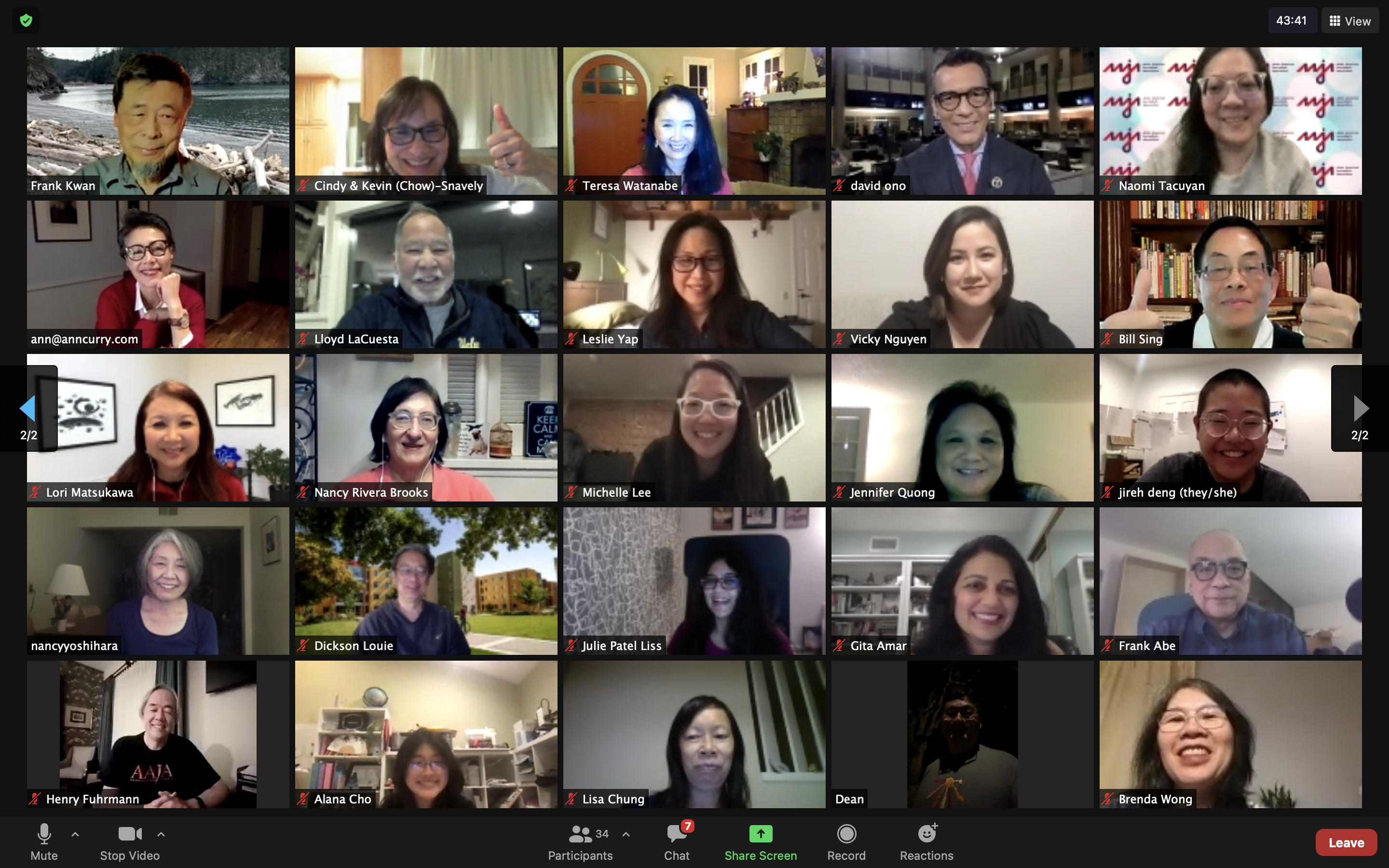AAJA Founders Forum 2021
Alana Cho
Nancy Yoshihara, David Kishiyama, and Bill Sing broke away from their predetermined paths — as a dental hygienist, architect, and economist, respectively — to follow their passion for journalism.
That revolutionary act was followed by another: They banded together, joined by Tritia Toyota, Dwight Chuman and Frank Kwan, to form the Asian American Journalists Association in 1981.
Their hard work and motivation to help future generations led AAJA to flourish for the past 40 years and it has blossomed into an international 20-chapter organization that inspires and connects journalists around the world.
To commemorate the 40th anniversary of AAJA, the Los Angeles chapter hosted a Founders Forum with five of the six founders to discuss the past, present, and future of AAJA.
David Ono, KABC-TV news anchor, facilitated an engaging discussion between Sing, Yoshihara, Kishiyama, Kwan, and Chuman that informed hundreds of viewers — from Florida to as far away as Hong Kong — about the invaluable history and memories of AAJA.
This forum brought members back to AAJA’s core mission: “To increase AAPI perspectives and representation in newsrooms, media, and storytelling.”
That was especially needed around the time of the organization’s creation. Asian Americans and Pacific Islanders had been subjected to more than a century of racism and stereotyping, much of it fueled by the media. And Asian American and Pacific Islander journalists in newsrooms were vastly under-represented.
This motivated Bill Sing to found AAJA, as he aimed to address these prominent issues in the newsrooms. As a Stanford University student, Sing was inspired by Bill Wong, a legendary Oakland Tribune journalist who started Asians in Mass Media to combat racist and stereotypical coverage. Sing later joined the LA Times after graduating from Stanford, where he met Tritia and joined forces to create AAJA.
“The atmosphere back then, not just the early 80s but even beforehand, was that there was a true sense of some isolation simply because there just weren’t enough people who look like us around the station,” Kwan said.
In times of this isolation, Kwan said, the founders believed that it was crucial to “network so that you felt that your experiences, your hardships, and your challenges were not something that you faced alone but was something that we could take on in common.”
Some newsrooms, although not against the founding of AAJA, did not consider this organization as a potentially impactful movement. “I don’t think they necessarily took us seriously. I don’t think they necessarily thought that we could organize and pull this together and have a presence and have a say so,” Yoshihara said.
After laying the groundwork and coming together to executive this monumental idea, the founders had two main challenges – recruitment and fundraising.
The founders compiled lists of Asian-sounding names from bylines and event attendees to try and recruit members.
“The recruitment part was very tough…I remember getting really flatly turned down from people who we were cold calling from lists we built,” Kishiyama recalled. “When it came to money, that was something that was probably more difficult than ever because there were already other ethnic…news organizations, well established, and they were asking for money, too. And, in a sense, when we were asking for money from organizations, we were all trying to go after the same bag of coins.”
Although faced with many challenges, the founders of AAJA accomplished a vast amount even in the early days.
“I think among one of the greatest accomplishments of AAJA was its outreach to the community,” Yoshihara said. Under the umbrella of community outreach, AAJA offered scholarships, wrote and provided handbooks on covering the AAPI community, and provided helpful internships and mentorships for young aspiring journalists.
Yoshihara described her vision for AAPI journalists in the future: “One of the challenges for AAJA [then and now] is to really begin to move the journalists up the ranks. I think, to be able to be an editor of a major metropolitan paper, [or] to be able to be….at that top level where you kind of can call the shots and that based on your experience as a journalist, credentials, and your track record, everything takes you to a point where your influences are beyond the story, beyond the segment, and into sort of the stratosphere of what journalism is all about.”
Although the AAPI community has come a long way since the founding of AAJA, she said there is still a lot to accomplish to achieve true visibility, equity and representation in newsrooms.
Despite the odds, AAJA’s founders — Bill Sing, Nancy Yoshihara, David Kishiyama, Frank Kwan, Dwight Chuman, and Tritia Toyota — founded an active, robust organization that is dedicated to nurturing journalists and inspiring activism on issues affecting the AAPI community.
AAJA is an ever-growing family of journalists who collaborate, lift each other up, and band together in times of need. The need for AAJA is as apparent now as ever, as the organization leads and brings together communities and allies in raising awareness about and combating hate crimes against the AAPI community.


